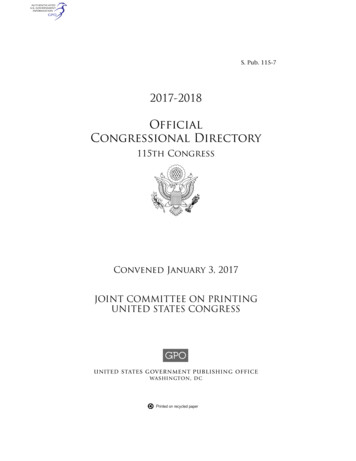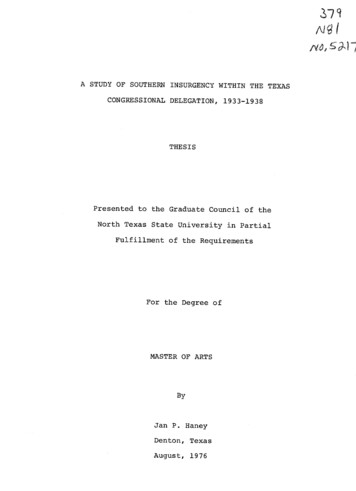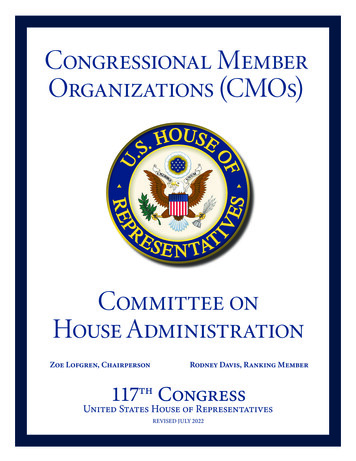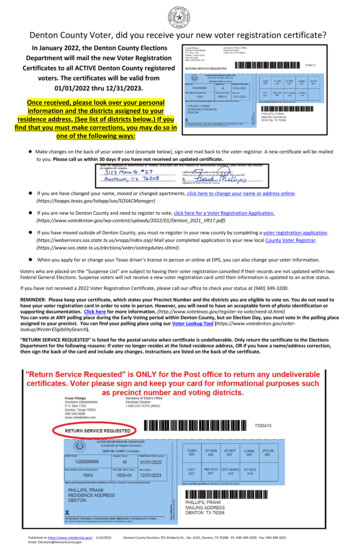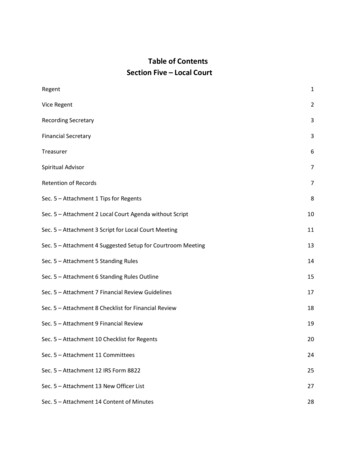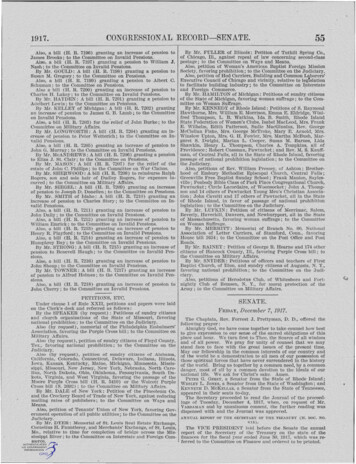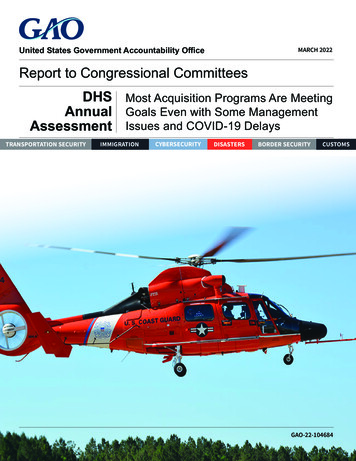
Transcription
United States Government Accountability OfficeMARCH 2022Report to Congressional CommitteesDHS Most Acquisition Programs Are MeetingAnnual Goals Even with Some ManagementAssessment Issues and COVID-19 DelaysTRANSPORTATION SECURITYIMMIGRATIONCYBERSECURITYDISASTERSBORDER SECURITYCUSTOMSGAO-22-104684
A Report to Congressional CommitteesMarch 2022DHS Annual AssessmentMost Acquisition Programs Are Meeting Goals Even withSome Management Issues and COVID-19 DelaysHighlights of GAO-22-104684Why GAO Did This StudyWhat GAO FoundIn 2015, a Senate report included aprovision for GAO to review DHS’smajor acquisitions. This is GAO’sseventh review of the cost andschedule performance of selectedmajor DHS acquisition programs.This report examines the extent towhich these programs are meetingbaseline goals and describes effortsto mitigate COVID-19–relatedeffects on delivery of capabilities toend users.The Department of Homeland Security (DHS) invests billions of dollars annuallyto acquire systems that help secure the border, increase marine safety, screentravelers, enhance cybersecurity, improve disaster response, and execute a widevariety of other operations.GAO assessed 29 acquisitionprograms, including DHS’s largestprograms and those that GAOidentified as at risk of pooroutcomes, to determine programstatus as of September 30, 2021.GAO assessed progress in meetingcost and schedule goals; reviewedpolicy, memorandums, andinformation about the cost andschedule effects of COVID-19; andinterviewed DHS officials.View GAO-22-104684. For more information,contact Marie A. Mak at (202) 512-4841 ormakm@gao.gov.As of September 2021, 23 of the 29 programs GAO selected for this review haddeveloped a DHS-approved acquisition program baseline—establishing how thesystem being acquired will perform, when it will be delivered, and what it willcost—and 20 of those 23 programs were meeting their goals. However, fiveprograms exceeded their cost or schedule goals, or both, at some point duringfiscal year 2021. Reasons for the breaches included external factors, such asCOVID-19, and an underestimation of program complexity. While two of thesefive programs restructured their baseline goals to get back on track, theremaining three were still in breach status as of September 2021 (see table).DHS Major Acquisition Programs in Breach of Approved Cost or Schedule Goals (or both) asof September 2021Program (baseline life-cycle cost)Breach typeHomeland Advanced Recognition Technology ( 3.9 billion)Cost and scheduleMedium Range Surveillance Aircraft ( 15.2 billion)ScheduleNational Bio and Agro-Defense Facility ( 1.3 billion)ScheduleSource: GAO analysis of Department of Homeland Security data GAO-22-104684Additionally, GAO found that nine programs that were meeting their currentlyestablished goals rebaselined or were in the process of doing so in fiscal year2021 due to scope changes, such as a change in quantities, an extended lifecycle, or additional funding from Congress.As of September 2021, GAO found that four programs used a DHS policyallowing programs to adjust schedule milestones up to 6 months due to theeffects of COVID-19. These effects included workforce absences due to stay-athome orders and supply chain delays for needed parts. In most cases, programswere able to mitigate the effects of COVID-19 without baseline adjustments.United States Government Accountability Office
ContentsLetterAppendix I1BackgroundMajority of Selected Programs Were Meeting Established Goals inFiscal Year 2021, with Fewer in Breach Status than Prior YearMost Programs Were Able to Address Reported Cost or ScheduleEffects from COVID-19 without Requiring Baseline AdjustmentMemorandumsAgency Comments2327Program Assessments29Continuous Diagnostics and Mitigation (CDM)National Cybersecurity Protections System (NCPS)Next Generation Network Priority Services (NGN PS) Phase 1Next Generation Network Priority Services (NGN PS) Phase 2Homeland Advanced Recognition Technology (HART)Grants Management Modernization (GMM)National Bio and Agro-Defense Facility (NBAF)Checkpoint Property Screening Program (CPSS)Credential Authentication Technology (CAT)270’ Medium Endurance Cutter (MEC) Service Life ExtensionProgram (SLEP)Fast Response Cutter (FRC)H-65 Conversion/Sustainment Program (H-65)Long Range Surveillance Aircraft (HC-130J)Medium Range Recovery Helicopter (MH-60T) SustainmentProgramMedium Range Surveillance Aircraft (MRS)National Security Cutter (NSC)Offshore Patrol Cutter (OPC)Polar Security Cutter (PSC)Waterways Commerce Cutter (WCC)Automated Commercial Environment (ACE)Biometric Entry-Exit (BE-E) ProgramBorder Wall System ProgramCross Border Tunnel Threat (CBTT)Integrated Fixed Towers (IFT)Medium Lift Helicopter (MLH)Multi-Role Enforcement Aircraft (MEA)Non-Intrusive Inspection (NII) Systems and NII IntegrationProgramsRemote Video Surveillance System (RVSS)313335373941434547Page 04684 DHS Annual Assessment
Appendix IIObjectives, Scope, and Methodology89Appendix IIIGAO Contact and Staff Acknowledgments94Appendix IVAdditional Source Information for Images and Figures95TablesTable 1: DHS Major Acquisition Programs Selected for ReviewTable 2: Selected Documents Approved by DHS Headquarters atAcquisition Decision Events (ADE) For Major Acquisitionsof Capital AssetsTable 3: Department of Homeland Security Program Status as ofSeptember 2021Table 4: Programs That Were in Breach of Cost or ScheduleGoals in Fiscal Year 2021Table 5: Programs That Rebaselined or Were Rebaselining inFiscal Year 2021Table 6: DHS Major Acquisition Programs RemediatingPerformance Issues during Fiscal Year 2021Table 7: Programs That Adjusted Their Schedule Baselines inFiscal Year 2021 due to the Effects of COVID-19Table 8: DHS Major Acquisition Programs Reporting COVID-19Effects That Did Not Require Baseline AdjustmentMemorandums in Fiscal Year 2021Table 9: Rationale for Selecting DHS Major Acquisition Programsfor Review5816182021232590FiguresFigure 1: DHS Acquisition Life Cycle for Major AcquisitionProgramsFigure 2: Department of Homeland Security’s AcquisitionManagement StructureFigure 3: Test and Evaluation Activities Established by DHS Policywithin the Obtain PhasePage ii71114GAO-22-104684 DHS Annual Assessment
SPARMPC&ITEMPacquisition decision eventacquisition program baselineanalysis of alternativesCoronavirus Disease 2019Department of Homeland SecurityDirector, Office of Test and EvaluationJoint Requirements Councilkey performance parameterlife-cycle cost estimateoperations and supportOffice of Program Accountability and Risk Managementprocurement, construction, and improvementstest and evaluation master planThis is a work of the U.S. government and is not subject to copyright protection in theUnited States. The published product may be reproduced and distributed in its entiretywithout further permission from GAO. However, because this work may containcopyrighted images or other material, permission from the copyright holder may benecessary if you wish to reproduce this material separately.Page iiiGAO-22-104684 DHS Annual Assessment
Letter441 G St. N.W.Washington, DC 20548March 8, 2022Congressional CommitteesEach year, the Department of Homeland Security (DHS) invests billions ofdollars in a diverse portfolio of major acquisition programs to help executeits many critical missions. DHS and its components are acquiring systemsto help secure the border, increase marine safety, screen travelers,enhance cybersecurity, improve disaster response, and execute a widevariety of other operations. In fiscal year 2022 alone, DHS plans to spendover 5 billion on these acquisition programs, and, ultimately, thedepartment plans to invest more than 240 billion over the life cycle ofthese programs. Most of DHS’s major acquisition programs have lifecycle costs of at least 300 million and take multiple years to acquire. 1To help manage these programs, DHS established an acquisitionmanagement policy in 2008, and department leadership has dedicatedresources and implemented additional guidance designed to improveacquisition oversight. We have found the policy to be generally sound inthat it reflects key program management practices identified in our priorwork. However, we have found shortfalls in executing the policy.Furthermore, we have highlighted DHS acquisition management issues inour high-risk updates since 2005 and made numerous recommendationsover the past decade to help address these challenges. 2DHS has made progress in responding to some of theserecommendations but has not fully addressed all of them. For example, inOctober 2020, we recommended that DHS should ensure the Office ofProgram Accountability and Risk Management (PARM) and componentheads implement the nomination process for Component Acquisition1DHSdefines major acquisition programs as those with life-cycle cost estimates of 300million or more. In some cases, DHS may define a program with a life-cycle cost estimateless than 300 million as a major acquisition if it has significant strategic or policyimplications for homeland security, among other things.2GAO,Homeland Security: DHS Requires More Disciplined Investment Management toHelp Meet Mission Needs, GAO-12-833 (Washington, D.C.: Sept. 18, 2012); and HighRisk Series: An Update, GAO-05-207 (Washington, D.C.: Jan. 1, 2005). For our mostrecent report, see High-Risk Series: Dedicated Leadership Needed to Address LimitedProgress in Most High-Risk Areas, GAO-21-119SP (Washington, D.C.: Mar. 2, 2021).Page 1GAO-22-104684 DHS Annual Assessment
Executives consistently as described in DHS guidance. 3 Although DHSconcurred with our recommendation and has taken steps to address it,the department is still in the process of formally documenting its actions.Additionally, in December 2019, we found that major acquisitionprograms’ schedule goals did not trace to the integrated masterschedules in accordance with DHS guidance. 4 We recommended thatDHS revise the schedule development guidance and create an oversightprocess to confirm that programs’ schedule goals are developed andupdated to ensure traceability between acquisition program baseline(APB) schedule goals and integrated master schedules in accordancewith GAO’s Schedule Assessment Guide. 5 In response to ourrecommendation, DHS published a revised version of its SystemsEngineering Life Cycle instruction and the accompanying guidebook inFebruary 2021 and May 2021, respectively. However, as of September2021, DHS had not completed efforts to create an oversight process.The Explanatory Statement accompanying a bill to the DHSAppropriations Act, 2015 contained a provision for GAO to conductreviews of major DHS acquisition programs, as directed in the Senatereport. 6 This is our seventh such review. This report (1) examines theextent to which selected DHS major acquisition programs are meetingtheir baseline goals and (2) describes the programs’ efforts to mitigateCoronavirus Disease 2019 (COVID-19)-related cost and schedule effects.To answer these objectives, we reviewed 29 of DHS’s 37 majoracquisition programs identified in the department’s January 2021 MasterAcquisition Oversight List. DHS defines major acquisitions as level 1 forprograms with life-cycle cost estimates (LCCE) of 1 billion or more andlevel 2 as programs with LCCEs from 300 million to less than 1 billion.We selected 13 of DHS’s 14 level 1 acquisition programs, as of January2021, that were in the process of obtaining new capabilities—which DHS3GAO,Homeland Security Acquisitions: DHS Has Opportunities to Improve Its ComponentAcquisition Oversight, GAO-21-77 (Washington, D.C.: Oct. 20, 2020).4GAO,Homeland Security Acquisitions: Outcomes Have Improved but Actions Needed toEnhance Oversight of Schedule Goals, GAO-20-170SP (Washington, D.C.: Dec. 19,2019).5GAO,Schedule Assessment Guide: Best Practices for Project Schedules, GAO-16-89G(Washington, D.C.: Dec. 22, 2015).6ExplanatoryStatement submitted by Mr. Rogers of Kentucky, Chairman of the HouseCommittee on Appropriations, regarding H.R. 240, Department of Homeland SecurityAppropriations Act, 2015, (161 Cong. Rec., H-276 (Jan. 13, 2015).Page 2GAO-22-104684 DHS Annual Assessment
policy defines as the obtain phase of the acquisition life cycle. Weselected 16 other major acquisition programs that we identified as at riskof not meeting their schedules, cost estimates, or capability requirements.These include two level 2 acquisitions in the obtain phase and 14 level 1or level 2 programs that had not yet entered or were beyond the obtainphase. We excluded eight major acquisition programs for a variety ofreasons, including lower risk programs already in deployment and toavoid duplication with other ongoing GAO reviews.To determine the extent to which the 29 programs we selected weremeeting their schedule and cost goals, we collected key acquisitiondocumentation, such as APBs, which contain information on programs’schedules and costs. Since the November 2008 update to DHS’soverarching acquisition management directive, these documents haverequired DHS-level approval; therefore, consistent with our priorassessments, we used November 2008 as the starting point for ouranalysis. We found that 24 of the 29 programs had one or moredepartment-approved APBs between November 2008 and September 30,2021. The remaining five programs do not yet have department-approvedAPBs, and, as a result, we excluded them from our portfolio analysis. Wealso excluded the Border Wall System Program from the aggregatedanalyses due to the January 2021 Presidential Proclamation directing apause in the construction of the border wall to the extent permitted bylaw. 7 However, all 29 programs received individual assessments, asdiscussed below.To determine the programs’ efforts to mitigate COVID-19–related costand schedule effects, we first reviewed the October 2020 DHSmemorandum granting level 1 and selected level 2 programs the authorityto adjust their APB schedule baseline goals up to 6 months due to effectsrelated to COVID-19. We then reviewed baseline adjustment memosassociated with programs that made use of this authority. We alsointerviewed officials at the programs that were associated with theseadjustment memos and at those that were not to understand the cost andschedule effects they had seen as a result of COVID-19 and the stepsthey had taken to attempt to mitigate these effects.Appendix I presents individual assessments of and information abouteach of the 29 programs we reviewed, including the six excluded from our7GAO,Southwest Border: Schedule Considerations Drove Army Corps of Engineers’Approaches to Awarding Construction Contracts through 2020, GAO-21-372 (Washington,D.C.: June 17, 2021).Page 3GAO-22-104684 DHS Annual Assessment
portfolio analysis. These assessments include key information such asthe status of programs’ schedules, costs, and test and evaluation. Ourtwo-page assessments are intended to provide decision makers a meansto quickly gauge the programs’ progress and the extent to which they faceany cost, schedule, performance, or program risks. See table 1 for the fulllist of programs we reviewed.Page 4GAO-22-104684 DHS Annual Assessment
Table 1: DHS Major Acquisition Programs Selected for ReviewComponentProgramCybersecurity and InfrastructureSecurity AgencyContinuous Diagnostics and Mitigation1National Cybersecurity Protection System1Next Generation Networks - Priority Services Phase 12Next Generation Networks - Priority Services Phase 22DHS Management DirectorateHomeland Advanced Recognition Technology1Federal Emergency ManagementAgencyGrants Management Modernization2Science and TechnologyDirectorateNational Bio and Agro-Defense Facility1Transportation SecurityAdministrationCheckpoint Property Screening System1Credential Authentication Technology2U.S. Coast Guard270’ Medium Endurance Cutter Service Life ExtensionProgram1Fast Response Cutter1H-65 Conversion/Sustainment Program1Long Range Surveillance Aircraft (HC-130J)1Medium Range Recovery Helicopter (MH-60T)1Medium Range Surveillance Aircraft1National Security Cutter1Offshore Patrol Cutter1Polar Security Cutter1Waterways Commerce Cutter1Automated Commercial Environment1Biometric Entry-Exit Program1Border Wall System Program1Cross Border Tunnel Threat1Integrated Fixed Towers2Medium Lift Helicopter1Multi-Role Enforcement Aircraft1Non-Intrusive Inspection Systems1Non-Intrusive Inspection Integration1Remote Video Surveillance System1U.S. Customs and BorderProtectionAcquisition levelLegend: shaded rows the program has not yet established an acquisition program baseline approved by DHS leadership.Source: GAO analysis of Department of Homeland Security (DHS) data. GAO-22-104684Appendix II provides detailed information on our objectives, scope, andmethodology.Page 5GAO-22-104684 DHS Annual Assessment
We conducted this performance audit from December 2020 to March2022 in accordance with generally accepted government auditingstandards. Those standards require that we plan and perform the audit toobtain sufficient, appropriate evidence to provide a reasonable basis forour findings and conclusions based on our audit objectives. We believethat the evidence obtained provides a reasonable basis for our findingsand conclusions based on our audit objectives.BackgroundTo help manage its multi-billion dollar acquisition investments, DHS hasestablished policies and processes for acquisition management,requirements development, test and evaluation, and resource allocation.The department uses these policies and processes to deliver systemsthat are intended to close critical capability gaps, helping enable DHS toexecute its missions and achieve its goals.Acquisition ManagementPolicy and OversightDHS’s policies and processes for managing its major acquisitionprograms are primarily set forth in its Acquisition Management Directive102-01 and Acquisition Management Instruction 102-01-001. DHS issuedthe initial version of this directive in November 2008 in an effort toestablish an acquisition management system that effectively providesrequired capability to operators in support of the department’s missions.DHS has issued multiple updates to its acquisition management directiveand instruction, in part to be responsive to our recommendations. DHSissued the current version of the directive in February 2019 and thecurrent version of the instruction in January 2021.The Under Secretary for Management is the acquisition decision authorityfor the department’s largest acquisition programs, those with LCCEs of 1billion or greater, as well as some programs with cost estimates between 300 million and 1 billion. Component Acquisition Executives—typicallythe most senior acquisition management official within each DHScomponent—may be delegated acquisition decision authority forprograms with cost estimates between 300 million and 1 billion.DHS acquisition management policy establishes that a major acquisitionprogram’s acquisition decision authority shall review the program at aseries of predetermined acquisition decision events (ADE) to assesswhether the major program is ready to proceed through the acquisitionlife-cycle phases. Depending on the program, these events can occurwithin months of each other or be spread over several years. The 2019revision to the DHS acquisition management policy modified entrancecriteria for ADEs. For example, the revised policy requires acquisitiondecision authority approval of APBs by ADE 2B. Under a prior version ofPage 6GAO-22-104684 DHS Annual Assessment
the policy, acquisition decision authority approval of the APB occurred atADE 2A. Figure 1 reflects the current acquisition life cycle in DHSacquisition management policy.Figure 1: DHS Acquisition Life Cycle for Major Acquisition ProgramsNote: Programs may develop capabilities through individual projects, segments, or increments, whichare approved at ADE 2B. Programs without individual projects, segments, or increments may conducta combined ADE 2A/2B since ADE 2B is the first milestone at which programs are required to submitcertain acquisition documents.An important aspect of an ADE is the acquisition decision authority’sreview and approval of key acquisition documents. See table 2 for adescription of the type of key acquisition documents identified in theJanuary 2021 acquisition instruction that requires department-levelapproval for major acquisitions of capital assets.Page 7GAO-22-104684 DHS Annual Assessment
Table 2: Selected Documents Approved by DHS Headquarters at Acquisition Decision Events (ADE) For Major Acquisitions ofCapital AssetsAcquisition Program Baseline (ADE 2B, 2C, 3) Establishes a program’s critical baseline cost, schedule, and performance parametersExpresses the parameters in measurable, quantitative terms, which must be met in order to accomplish the program’s goalsAnalysis of Alternatives (AoA) Study Plan (ADE 2A) Sets assumptions, scope, and constraints for the AoA, which is an analytical comparison of selected solution alternatives to fulfilla capability gap or needCapability Development Plan (ADE 1) Serves as the agreement between the component head, program manager, and the acquisition decision authority on theactivities, cost, and schedule for the analysis and selection of potential solutions to fill a mission needIntegrated Logistics Support Plan (ADE 2B, 2C, 3) Defines the strategy for ensuring the supportability and sustainment of a future capabilityProvides critical insight into the approach, schedule, and funding requirements for integrating supportability requirements into thesystems engineering processLife-Cycle Cost Estimate (ADE 2A, 2B, 2C, 3) Provides an exhaustive and structured accounting of all resources and associated cost elements required to develop, produce,deploy, and sustain a particular programMission Need Statement (ADE 1) Synopsizes at a high-level the specific capabilities required to accomplish DHS’s mission objectives, along with deficiencies andgaps in these capabilitiesOperational Requirements Document (ADE 2A) Captures the business or operational user requirements and identifies which of these requirements are key performanceparameters Describes the mission, objectives, and capabilities in operationally relevant termsSystem Engineering Life Cycle Tailoring Plan (ADE 2A, 2B, 2C, 3) Tailors the phases, products, and reviews in the System Engineering Life Cycle to meet the specific needs of each program andprojectTechnical Assessment (ADE 2A) Provides relevant information on the technical maturity, manufacturing capability, and technical risk of a planned technologyTest and Evaluation Master Plan (ADE 2A, 2C) Documents the overarching test and evaluation approach for the acquisition programDescribes the developmental and operational test and evaluation needed to determine a system’s technical performance andoperational effectiveness/suitability/resilienceSource: GAO analysis of Department of Homeland Security (DHS) information. GAO-22-104684DHS acquisition management policy states that the APB is the agreementbetween the acquisition program, component, and department-levelofficials that establishes how systems being acquired will perform, whenthey will be delivered, and what they will cost. Specifically, the APBestablishes a program’s schedule, costs, and key performanceparameters (KPP). DHS requirements policy describes KPPs as aPage 8GAO-22-104684 DHS Annual Assessment
program’s most important and nonnegotiable requirements that a systemmust meet to fulfill its fundamental purpose. For example, a KPP for anaircraft may be airspeed, and a KPP for a surveillance system may bedetection range.In a 2019 revision to DHS’s acquisition policy, DHS modified the way inwhich APBs for major acquisition programs are developed and approved.Specifically, the policy now states that a preliminary APB—approved byComponent Acquisition Executives—is required at ADE 2A. Thepreliminary APB is updated, as necessary, and submitted to theacquisition decision authority for approval to support ADE 2B. Bycontrast, the prior version of the acquisition policy required the acquisitiondecision authority to approve an initial APB at ADE 2A. Obtainingacquisition decision authority approval of the APB later in the acquisitionlife cycle allows programs to better define technical requirements prior toapproval.The APB establishes objective (target) and threshold (maximumacceptable for cost, latest acceptable for schedule, and minimum ormaximum acceptable for performance) baselines. According to DHSpolicy, if a program fails to meet any schedule, cost, or performancethreshold approved in the APB, it is considered to be in breach. Programsin breach status are required to notify their acquisition decision authorityand develop a remediation plan that outlines a time frame for the programto return to its APB parameters, rebaseline—that is, establish newschedule, cost, or performance goals—or have a DHS-led programreview that results in recommendations for a revised baseline.In addition to the acquisition decision authority, other bodies and seniorofficials support DHS’s acquisition management function: The Acquisition Review Board reviews major acquisition programsfor proper management, oversight, accountability, and alignment withthe department’s strategic functions at ADEs and other meetings asneeded. The board is chaired by the acquisition decision authority or adesignee and consists of members and representatives who manageDHS’s mission objectives, resources, and contracts. The Line of Business Chiefs include the DHS Chief FinancialOfficer, the Chief Information Officer, the Chief Procurement Officer,the Chief Human Capital Officer, the Chief Security Officer, and theChief Readiness Support Officer, among others. The Line of BusinessChiefs have responsibility for executing acquisition portfolios and areresponsible and accountable for adhering to the department’sPage 9GAO-22-104684 DHS Annual Assessment
acquisition policies and procedures to ensure sound management,review, support, and approval. The Line of Business Chiefs are alsomembers of the Acquisition Review Board. The Office of Program Accountability and Risk Management isresponsible for DHS’s overall acquisition governance process,supports the Acquisition Review Board, and reports directly to theUnder Secretary for Management. PARM develops and updatesacquisition program management policies and procedures, reviewsmajor programs, provides guidance for workforce planning activities,and provides support to program managers. Components, such as U.S. Customs and Border Protection (CBP),the Transportation Security Administration, and the U.S. Coast Guardsponsor specific acquisition programs. 8 The head of each componentis responsible for oversight of major acquisition programs once theprograms complete delivery of all planned capabilities to end users. Component Acquisition Executives within the components areresponsible for overseeing the execution of their respectiveportfolios. In July 2021, DHS established a Component AcquisitionExecutive position within the Management Directorate. Accordingto officials, this position is to oversee acquisition programs beingexecuted within the Lines of Business. Program management offices, also within the components, areresponsible for planning and executing DHS’s individualprograms. They are expected to do so within the cost, schedule,and performance parameters established in their APBs. If theycannot do so, programs are considered to be in breach and musttake specific steps, as noted above.Figure 2 depicts the relationship between acquisition program managersat the department, component, and program level.8DHS’scomponents consist of operational components—those that have responsibility fordirectly achieving one or more of the department’s missions or activities—and supportcomponents—those that generally provide assistance or guidance to other DHScomponents or external organizations. For example, the Management Directorate is asupport component that generally provides assistance and guidance to other DHScomponents and external organizations and includes functions like budget, finance,information technology, facilities, human capital, and acquisitions. However, theManagement Directorate also manages acquisition programs. Typically, these programsare those that involve multiple components, such as programs related to relocating theDHS headquarters and updates to financial systems for multiple components.Page 10GAO-22-104684 DHS Annual Assessment
Figure 2: Department of Homeland Security’s Acquisition Management StructureRequirementsDevelopment ProcessIn 2008, we found that DHS had not effectively implemented or adheredto its review process for major acquisitions and recommended that DHSreinstate the Joint Requirements Council (JRC) to review and approveacquisition requirements and assess potential duplication of effort acrossPage 11GAO-22-104684 DHS Annual Assessment
the department. 9 In June 2014, DHS reestablished a JRC to develop andlead a component-driven joint requirements process for the department.In March 2016, DHS revised its policy instruction to reflect the addition ofthe JRC as an acquisition oversight body.Among other responsibilities, the JRC is to provide requirements-relatedadvice and validate key acquisition documentation to prioritizerequirements and inform DHS investment decisions among itscomponents. The JRC chair is a member of the Acquisition Review Boardand advises the board on capability gaps, needs, and requirements at keymilestones in the acquisition life cycle. In March 2019, we reported thatthe JRC could better fulfill its mission by identifying overlapping orcommon requirements and by making recommendations to seniorleadership to inform budget decisions and to help ensur
home orders and supply chain delays for needed parts. In most cases, programs . Homeland Security Acquisitions: Outcomes Have Improved but Actions . 6Explanatory Statement submitted by Mr. Rogers of Kentucky, Chairman of the House Committee on Appropriations, regarding H.R. 240, Department of Homeland Security Appropriations Act, 2015, (161 .

